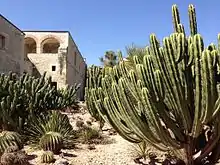
The Jardín Etnobotánico de Oaxaca is a botanical garden in Oaxaca City, Mexico. It occupies 2.32 acres of land adjacent to the Church of Santo Domingo.[1] It is administered by the state government of Oaxaca.
History
In 1993, a proposal for the creation of the Ethnobotanical Garden was put forth by Francisco Toledo, a renowned artist from Oaxaca, and the civil association PRO-OAX (Board for the Defense and Conservation of the Cultural and Natural Heritage of Oaxaca, A.C.).[2] Francisco Toledo was interested in preserving and promoting the traditional knowledge of the Zapotec and Mixtec peoples of the Oaxaca region. The artist was a constant activist and his struggles led him to win great and surprising battles, such as preventing, alongside ProOax, the conversion of the former Convent of Santo Domingo de Guzmán (a colonial-era building) into a large parking lot and managing to turn it into the current Santo Domingo Cultural Center, which houses the Museum of Cultures and the Ethnobotanical Garden.[3]
Toledo collaborated with anthropologist Alejandro de Ávila Blomberg to design the garden, which showcases the rich diversity of plant species used by indigenous communities in the region for food, medicine, and cultural practices. The garden also includes an herbarium, a library, and a laboratory for the study of ethnobotany.
Species
Some of the species found in the garden include:[4]
- Agave: A genus of succulent plants that are used for various purposes, including the production of alcoholic beverages like mezcal and tequila.
- Cactus: A family of plants that are adapted to arid environments and are used for food, medicine, and ornamental purposes.
- Amaranth: A type of grain that was an important staple food for the Aztecs and is still used today in various dishes.
- Vanilla: A tropical orchid that is the source of the popular flavoring used in many foods and beverages.
- Medicinal plants: The garden features a wide range of medicinal plants that are used in traditional medicine to treat various ailments.
- Fruit trees: The garden also includes a variety of fruit trees, such as papayas, guavas, and mangoes, which are important sources of food in the region.
The garden showcases the rich biodiversity of the region and the importance of plants to the local communities.

References
- ↑ "Jardín Etnobotánico de Oaxaca". Botanic Gardens Conservation International. Retrieved 25 January 2016.
- ↑ https://jardinoaxaca.mx/estructura-institucional/
- ↑ https://inba.gob.mx/prensa/14386/francisco-toledo-incansable-activista-y-creador-de-instituciones
- ↑ Oaxaca, Jardín Etnobotánico de. "Colecciones". Jardín Etnobotánico de Oaxaca. Retrieved 2023-03-30.
External links
 Media related to Jardin Etnobotanico, Oaxaca de Juárez at Wikimedia Commons
Media related to Jardin Etnobotanico, Oaxaca de Juárez at Wikimedia Commons